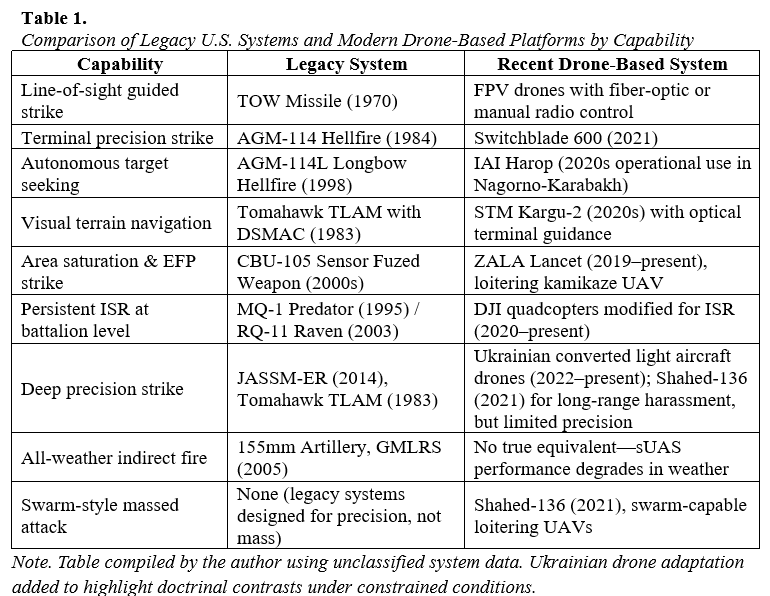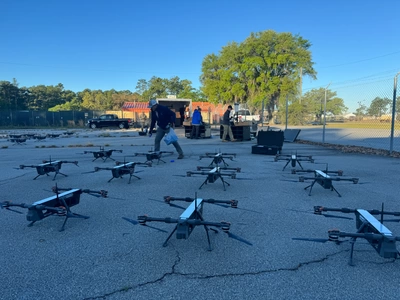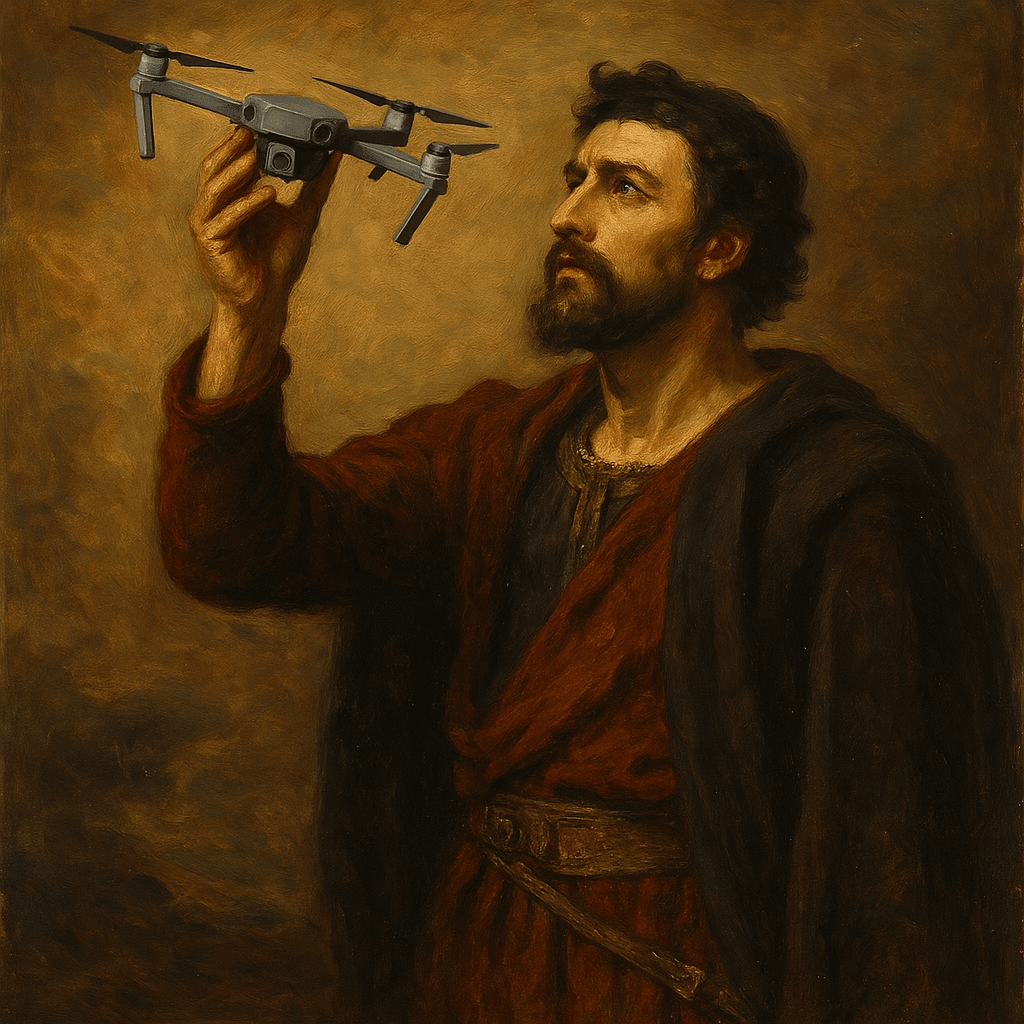Why Unmanned Aerial Systems Are Evolutionary, Not Revolutionary for U.S. Warfare
Disclaimer: The views expressed in this article are those of the author and do not reflect the official policy or position of the Department of Defense or the U.S. Government.
The appearance of external hyperlinks does not constitute endorsement by the United States Department of Defense (DoD) of the linked websites, or the information, products, or services contained therein. The DoD does not exercise any editorial, security, or other control over the information you may find at these locations.
Introduction
The proliferation of small unmanned aerial systems (sUAS) across modern battlefields has generated significant discourse about their role in the future of warfare. From the trenches of eastern Ukraine to the dense urban combat zones of Gaza, these platforms have delivered impressive tactical effects—from real-time intelligence, surveillance, and reconnaissance (ISR) to precision strikes at remarkably low cost. This widespread visibility has prompted some analysts and policymakers to frame sUAS as revolutionary tools, capable of redefining force structure, deterrence, and combat itself (Kallenborn, 2023; Bennett, 2022). However, such interpretations risk overlooking the fundamental distinctions between how peer competitors fight and how the United States conducts military operations. The American approach to war—characterized by maneuver, air and missile dominance, and rapid tempo—places different demands on emerging technologies. While sUAS present undeniable advantages in specific environments, their impact within the U.S. doctrinal context is best understood as evolutionary, not revolutionary. To ensure an effective future force, it is essential to critically assess these systems not only by what they can do, but by how they align—or fail to align—with American ways of war.
The U.S. Does Not Fight Static Wars
The operational context in which small unmanned aerial systems (sUAS) have proven most effective—static, attritional warfare—is fundamentally different from the manner in which the United States traditionally conducts large-scale combat operations. American campaigns are deliberately designed to avoid protracted positional engagements, emphasizing speed, disruption, and maneuver over territory-holding and linear frontlines. From the first air strikes in Operation Desert Storm to the integrated campaign in Iraq in 2003, U.S. force projection has been predicated on rapid degradation of enemy air defenses, command and control, and logistical infrastructure through a combination of deep fires, precision strike, and electronic warfare. This approach typically unfolds in two phases: the first characterized by suppression of enemy air defenses (SEAD), long-range missile strikes, and joint air operations to secure freedom of action; the second focused on joint maneuver warfare supported by persistent ISR, integrated fires, and tempo-driven exploitation of enemy vulnerabilities (Department of the Army, 2022).
In contrast, the success of sUAS in recent conflicts has been most apparent in static environments, where frontlines remain relatively fixed, and opposing forces are often unable to contest airspace or maneuver with operational fluidity. In Ukraine, for example, both Russian and Ukrainian forces have leveraged sUAS for tactical ISR and precision fires across trench lines and fixed defensive positions. The persistent drone presence has enabled rapid target acquisition for artillery, nighttime interdictions of vehicle columns, and the harassment of rear-echelon logistics—effects that would be difficult to replicate in a fluid battlespace (Watling & Reynolds, 2023). Similarly, non-state actors in the Middle East, operating under air-denied but geographically confined conditions, have used drones for strategic messaging, assassination attempts, and attritional targeting (Bennett, 2022). These cases underscore the tactical versatility of sUAS but also reveal a critical limitation: their effectiveness depends on environmental and doctrinal factors that are rarely present in American campaigns.
The United States maintains both technological superiority and doctrinal preference to fight in ways that reduce exposure to protracted ground entrenchment. When American forces engage, they often do so with local air superiority, long-range ISR, and the capacity to collapse enemy decision-making through precision effects rather than attritional firepower. This fundamental difference in operating conditions matters greatly when assessing the role of sUAS in future U.S. operations. Applying lessons from environments where neither side has air dominance, where logistics are vulnerable for weeks at a time, or where ISR is managed at the squad level due to necessity, risks mistaking the context-specific success of sUAS for a universal solution. The American way of war is not static, and systems optimized for static conditions must therefore be critically scrutinized before being adopted at scale.
A Tool of Harassment, Not Transformation
While small unmanned aerial systems (sUAS) have demonstrated considerable utility on contemporary battlefields, their effects have largely remained tactical—valuable for harassment, interdiction, and shaping actions, but far from delivering strategic outcomes. Their success has often been overstated, in part due to the visibility and accessibility of drone footage, but this should not be conflated with doctrinal relevance. In the United States military context, operational and strategic effects are typically achieved through synchronized, high-confidence strikes that decisively alter the enemy’s capacity to command, maneuver, or resupply. By contrast, the role sUAS has most commonly played, delivering single munitions to static targets, disrupting enemy resupply nodes, or saturating the enemy with psychological pressure, is best understood as an extension of harassment fires rather than a new form of decisive warfare.

This distinction is especially apparent when comparing the employment of sUAS with traditional deep strike capabilities. Consider the 2017 U.S. response to the Syrian regime’s chemical weapons use at Al Shayrat Airbase. Rather than launching a drone swarm or relying on expendable tactical ISR platforms, the United States employed 59 Tomahawk Land Attack Missiles (TLAM) to neutralize key airfield infrastructure with high precision and zero risk to aircrews (Department of Defense, 2017). This strike exemplified how the U.S. military executes strategic effects: overwhelming, calibrated, and synchronized to achieve political and operational aims. It also underscores a critical point—when the United States needs to decisively degrade an enemy’s operational capability, it does not rely on cheap, small drones. It leverages precision long-range fires, joint airpower, and ISR fusion across domains.
In static environments, particularly where logistics are exposed and defenses are fixed, sUAS can indeed impose costs and generate friction. They are excellent tools for attritional pressure—attacking supply convoys, harassing command posts, or targeting sleeping infantry in dugouts. However, this is not the kind of warfare the United States prefers or prepares for. The American emphasis remains on tempo, overmatch, and maneuver. Within that framework, sUAS lack the payload, reliability, and survivability to function as a substitute for established strike capabilities. They are effective tools of harassment—but they are not tools of transformation.
Where sUAS Actually Shine
Despite their limitations in achieving strategic effects within U.S.-style campaigns, small unmanned aerial systems (sUAS) have demonstrated undeniable utility in certain operational environments. Their strengths, namely low cost, high accessibility, small physical signature, and real-time reconnaissance capability, translate well into urban warfare and decentralized tactical engagements, particularly where traditional platforms are constrained by risk, rules of engagement, or terrain.
Urban combat presents a highly complex battlespace in which concerns over collateral damage, sensor line-of-sight challenges, and the proximity of civilian populations often limit traditional fires. In such environments, sUAS can provide organic intelligence, surveillance, and reconnaissance (ISR) and light precision strike capabilities at the platoon or company level. Their ability to loiter over rooftops, scan alleyways, and track movement through urban canyons allows commanders to gain critical situational awareness without exposing dismounted patrols or risking manned aircraft in tightly confined airspace. Furthermore, sUAS can serve as force multipliers for small units conducting clearing operations or maintaining defensive perimeters in built-up areas, particularly when linked to handheld or vehicle-based fire support systems (Gerasimov, 2022; Watling, 2023).
Cost is another dimension in which sUAS shine. In theaters where the U.S. seeks to enable partner forces or conduct low-signature operations, the asymmetric cost advantage of drones is compelling. A commercially modified quadcopter costing a few thousand dollars can destroy or disable an asset worth several orders of magnitude more—a radar antenna, a fuel depot, or even an armored vehicle. For irregular forces or special operations elements, this cost-effectiveness provides a means of delivering effects without triggering large-scale escalation or committing scarce high-end assets. In places where airspace is permissive or surveillance is intermittent, the psychological and tactical value of drone swarms or single-shot kamikaze drones can complicate enemy decision-making, forcing dispersion, hardening, and increased logistics protection.
These advantages, however, are conditional—they are most relevant in constrained or permissive environments, where maneuver is limited and ISR saturation can yield disproportionate returns. They do not translate automatically into large-scale joint operations against peer adversaries. Nonetheless, within their niche, sUAS offer a viable complement to existing systems—particularly in urban combat, partner-enabled operations, and hybrid warfare settings where granular ISR and low-cost effects are decisive at the tactical edge. Their role is real—but it is situational, not systemic.
Weather and Environmental Tradeoffs
While small unmanned aerial systems (sUAS) provide a range of tactical advantages in certain environments, their performance is highly sensitive to weather and atmospheric conditions. In contrast to artillery, mortars, and other forms of indirect fire (IDF), which have long been valued for their resilience and reliability in all-weather operations, sUAS are often degraded—or entirely neutralized—by relatively modest environmental stressors. This fragility introduces a critical limitation to their utility in sustained, large-scale campaigns, especially for a military like the United States that prioritizes tempo, readiness, and operational reach across variable terrain and climates.
Environmental constraints affect sUAS across several domains. High winds reduce flight stability, endurance, and targeting precision, especially for lighter platforms commonly used for ISR or kamikaze strikes. Rain and humidity can impair exposed electronics, obstruct optical sensors, and reduce the effectiveness of infrared systems. Fog, snow, and dust degrade navigation accuracy and obstruct visual targeting, limiting both autonomous flight paths and real-time operator control. Even temperature extremes—both high and low—can impact battery performance and mechanical reliability. Collectively, these factors create significant windows of vulnerability, during which drone-dependent formations may lose both awareness and strike capability (Wright, 2023; Freedberg, 2021).
By contrast, artillery and mortar systems, though technologically mature, continue to offer dependable, all-weather firepower with minimal degradation in poor environmental conditions. These systems are not constrained by line-of-sight, can operate through fog, precipitation, and darkness, and can be fired from concealed or hardened positions without exposure to detection or jamming. Their logistical and operational signatures are well-understood, and they are integrated into every echelon of American maneuver warfare. While sUAS may provide valuable overwatch or targeting support, they cannot replace the all-weather reliability and responsiveness of IDF systems under most operational conditions.
Reliance on environmentally fragile platforms presents a serious risk for the U.S. military, which must be prepared to fight in the full spectrum of environments—from Pacific humidity to Arctic cold. This is not to suggest that drones have no place, but rather to emphasize that their use must be context-aware and complementary to more robust systems. A balanced approach acknowledges both their value and their limitations, especially in the face of unpredictable or adverse weather conditions that would not similarly hinder conventional fires.
These Capabilities Are Not New
The enthusiasm surrounding small unmanned aerial systems (sUAS), particularly loitering munitions and fiber-optic guided drones, often implies that these platforms represent an entirely new paradigm in warfare. However, many of the core capabilities now attributed to sUAS—autonomous terminal strike, visual navigation, and man-in-the-loop precision control—are in fact decades-old innovations. What has changed is the form factor, cost, and accessibility of the platforms, not the fundamental nature of the kill chain or guidance technologies.
The fiber-optic controlled first-person-view (FPV) drones seen in Ukraine closely resemble the legacy Tube-launched, Optically-tracked, Wire-guided (TOW) missile, developed in the 1960s and fielded by the U.S. Army in 1970. Like modern FPV drones, the TOW was line-of-sight dependent, manually guided by the operator during flight, and designed for precise engagement of armored targets from cover. It was neither autonomous nor revolutionary—but it was a game-changer in the anti-armor role for its time, much like small drones are proving tactically disruptive today (Federation of American Scientists, 2022).

Similarly, the AGM-114 Hellfire missile, introduced in 1984, has long embodied the core characteristics of modern loitering munitions. Early versions were guided via semi-active laser designation, requiring a designator to mark the target until impact. Later variants, such as the AGM-114L Longbow, introduced millimeter-wave radar seekers, enabling fire-and-forget targeting without a continuous external cue—effectively allowing the missile to seek its own target in cluttered environments. These capabilities remain foundational to many modern loitering drone systems, though drones may offer lower cost and longer loiter times in permissive airspace (Department of Defense, 2003).
The U.S. also pioneered autonomous visual navigation through the Tomahawk Land Attack Missile (TLAM), first fielded in 1983. The Tomahawk employed a layered guidance architecture including inertial navigation, terrain contour matching (TERCOM), and Digital Scene Matching Area Correlation (DSMAC)—a form of visual correlation enabling the missile to “see” and verify its final approach based on stored imagery. While less flexible than modern AI-driven object recognition, DSMAC represented a major leap in autonomous terminal precision, decades before today’s drone hype (GAO, 1999).

Even the concept of a munition autonomously seeking out and engaging targets in a designated area is not new. Systems like the CBU-105 Sensor Fuzed Weapon, operational in the 2000s, deployed submunitions that scanned for vehicles’ thermal or radar signatures and then engaged independently using explosively formed penetrators. This is functionally analogous to many current loitering munitions, albeit delivered via air-dropped cluster bombs rather than electric propellers (Jane’s, 2021).
These precedents matter. While today’s drones offer cost advantages, risk reduction, and novel employment methods, they are not strategic breakthroughs in terms of capability. They are the latest expression of a long-standing American tradition: integrating precision strike into maneuver warfare. Understanding them as part of a continuum—not as a radical break—will lead to more coherent force design and procurement strategies.
The U.S. Already Has What Drones Offer
Proponents of small unmanned aerial systems (sUAS) often suggest that these platforms fill critical gaps in modern warfare—delivering precision strike, persistent surveillance, and decentralized decision-making at the tactical edge. While this is true in under-resourced or non-integrated militaries, the United States already possesses a mature and layered architecture of intelligence, surveillance, and reconnaissance (ISR) and long-range strike capabilities. In many cases, sUAS offer not novel effects, but rather a smaller, less survivable, and more situationally constrained version of tools the U.S. has fielded for decades.
At the strategic level, the U.S. Department of Defense maintains a global ISR network composed of high-altitude platforms like the RQ-4 Global Hawk, MQ-9 Reaper, and ISR-enabled strike aircraft such as the F-35 Lightning II, whose sensor fusion systems provide persistent tracking and real-time targeting data across domains. These platforms operate with significantly higher endurance, sensor fidelity, and survivability than commercial-off-the-shelf drones or lightweight loitering munitions. Their integration into the broader command and control (C2) architecture allows for real-time queueing of fires, battle damage assessment, and synchronized effects across units and domains (Air Force Research Institute, 2020).
In terms of strike capabilities, the United States has long invested in a spectrum of precision-guided munitions and deep fires that offer similar, and often superior, functionality to sUAS-delivered payloads. Systems such as the Tomahawk Land Attack Missile (TLAM), Joint Air-to-Surface Standoff Missile (JASSM), Guided Multiple Launch Rocket System (GMLRS), and AGM-114 Hellfire provide scalable, survivable fires ranging from the theater to tactical level. These munitions are employed by manned and unmanned platforms across the joint force, offering precise, high-confidence effects without the fragility or weather sensitivity of quadcopters or foam-bodied kamikaze drones.
Additionally, the U.S. has institutionalized the concept of networked kill chains—a doctrinal and technological framework in which sensors, decision-makers, and shooters are interconnected to deliver synchronized effects. Programs such as Joint All-Domain Command and Control (JADC2) seek to further accelerate this integration, enabling rapid target acquisition, prioritization, and engagement at scale (Department of Defense, 2022). In this context, sUAS may provide local granularity, but they do not replace the integrated depth, redundancy, and survivability of U.S. kill chains.

An important caveat to this comparison is the Ukrainian military’s adaptation of converted fixed-wing aircraft into long-range one-way attack drones. These platforms, often repurposed from civilian or training aircraft, have demonstrated the ability to strike targets hundreds of kilometers away inside Russian territory. While tactically clever and operationally disruptive, such systems represent a weapon of necessity rather than one of doctrinal preference. They lack the precision, survivability, and systemic integration that define American deep-strike capabilities such as the Joint Air-to-Surface Standoff Missile (JASSM) or Tomahawk Land Attack Missile (TLAM). Their use highlights the creativity of a force operating under severe constraints—but it does not offer a model that the U.S. military needs or ought to replicate outside similarly desperate conditions (Watling & Reynolds, 2023).
The implication is not that sUAS have no value, but rather that their marginal utility must be measured against what already exists. When precision, survivability, integration, and strategic scalability are required, the United States already possesses the capabilities that sUAS are now being credited with inventing.
Tactical Utility vs. Strategic Effect
Small unmanned aerial systems (sUAS) have proven themselves to be highly effective at the tactical level, particularly in environments characterized by static frontlines, permissive airspace, and low-density force-on-force engagements. Their contributions to platoon- and company-level situational awareness, target identification, and light strike capability are real and increasingly integrated into training and operations across various armed forces. However, the fact that sUAS have tactical utility does not automatically confer strategic value, especially within the U.S. military framework, which requires systems to scale across echelons, domains, and tempo to achieve decisive outcomes.
At the tactical edge, sUAS provide ISR overwatch for dismounted patrols, conduct point target acquisition for indirect fire missions, and enable immediate post-strike battle damage assessment. In Ukraine, this has led to highly responsive artillery engagements and the ability to mass fires in ways that were previously impossible without satellite or aircraft-based ISR (Watling & Reynolds, 2023). The same applies to the use of loitering drones by non-state actors, who have weaponized commercial platforms to deliver explosives or conduct ISR in contested urban environments. These applications, however, function in localized, decentralized contexts and are not easily scalable to complex joint campaigns requiring integrated fires, airspace deconfliction, and synchronized operations across corps-level formations.
Strategic effect in U.S. doctrine is not measured by the number of enemy vehicles destroyed, but by the ability to dislocate enemy forces, paralyze command and control, and collapse adversary cohesion. This is achieved through joint integration of fires, maneuver, cyber, space, and information operations—capabilities that sUAS neither enable nor replace. They are vulnerable to jamming, lack survivability in contested airspace, and are not suited for deep strike, suppression of enemy air defenses (SEAD), or rapid operational maneuver. They also require significant data bandwidth, electronic support infrastructure, and operator time—resources that are limited and increasingly contested in peer conflict environments (Freier et al., 2022).
To conflate tactical disruption with operational or strategic breakthrough is to misunderstand the layered, integrated nature of American warfare. sUAS contribute valuable effects at the edge—but they do not generate momentum, shape theater-wide dynamics, or impose systemic paralysis on an enemy force. Their value is real, but it remains limited in scale, effect, and doctrinal integration.
The Next Ridgeline: Autonomous Swarms as Maneuver Elements
If there is a point on the horizon where small unmanned aerial systems (sUAS) could become truly transformational for U.S. military doctrine, it lies not in current tactical applications but in the future development of autonomous drone swarms capable of collective maneuver, mass, and adaptation. This concept envisions groups of drones operating as self-directed formations—able to sense, communicate, and act without centralized control, responding to changes in the battlespace in real time. Such swarms could conduct distributed reconnaissance, saturate enemy defenses, or perform multi-vector attacks that resemble the function of light cavalry or skirmishers in maneuver warfare.
The appeal of autonomous swarms lies in their potential to generate mass and complexity at low cost, overwhelming traditional point defenses and forcing adversaries to radically adapt their force posture and electronic warfare (EW) doctrine. In theory, these swarms could self-heal, re-task, and dynamically distribute fires across a target area—creating effects that are currently only achievable through synchronized joint fires or precision-guided munitions from manned platforms (Kallenborn, 2023). If realized, this capability would represent a doctrinally significant shift, one that challenges traditional force design, maneuver planning, and defensive integration.

However, the technological and operational barriers to such a development remain significant. True autonomy in a contested electromagnetic environment requires reliable edge processing, resilient communications, real-time sensor fusion, and AI-enabled decision-making—all under conditions of jamming, spoofing, and intermittent connectivity. Moreover, the legal, ethical, and command-and-control implications of allowing lethal autonomous systems to operate without human oversight remain unresolved across NATO and U.S. doctrine (Scharre, 2018). Even if technically feasible, the operational integration of autonomous swarms would require a fundamental shift in airspace management, fratricide avoidance, and fires coordination that the current doctrinal framework is not prepared to accommodate.
As drone swarming becomes more plausible, it is equally likely that countermeasures—both old and new—will reemerge to neutralize these capabilities. Traditional air defense methods, such as flak-style fragmentation bursts or rapid-fire autocannons, may regain relevance in countering low-flying, soft-bodied drones. Directed energy weapons, high-power microwave (HPM) systems, and electromagnetic pulse (EMP) devices are already being developed to disable swarms through area effects rather than kinetic interception. These systems could create a renaissance in short-range air defense, reversing decades of decline in favor of high-end missile interceptors and air superiority platforms (Freier et al., 2022).
In short, autonomous swarms represent the next ridgeline—not the current one. They hold genuine potential to reshape operational design, but that potential has not yet been realized. Mistaking this aspirational capability for an existing revolution risks investing in capabilities that are not yet scalable, survivable, or doctrinally grounded. For now, they remain a research priority—not a force design imperative.
What the U.S. Should Be Learning: Drone Defense and Fluency
While much of the U.S. defense conversation around small unmanned aerial systems (sUAS) focuses on adoption, replication, and integration, the more urgent imperative may be defensive. The real lesson from contemporary battlefields is not that the U.S. needs to become a drone-swarming force, but rather that it must learn how to survive and maneuver in a drone-saturated environment. Drones have become a ubiquitous and accessible threat, not just for state actors, but for irregular forces, proxies, and non-state adversaries. In this context, the U.S. military’s greatest near-term need is not more drones, but drone fluency: a force-wide understanding of how drones are employed, how to disrupt them, and how to operate effectively while under persistent observation or threat of precision strike.
sUAS challenged long-held assumptions about concealment, movement, and survivability. The ubiquity of cheap ISR platforms allows even low-capability forces to maintain near-continuous visual coverage of key terrain. Loitering munitions and FPV drones have made tactical positions, logistics hubs, and even sleeping areas vulnerable in ways that were once limited to adversaries with artillery spotters or overhead ISR. The result is a form of “persistent presence” that erodes freedom of maneuver, especially at lower echelons. U.S. units must relearn and reinforce camouflage, concealment, deception (C3D), electromagnetic discipline, and dispersed posturing—not as niche skills, but as essential survivability practices (Watling & Reynolds, 2023).
Moreover, every echelon of the U.S. force structure—from battalion to division—requires organic counter-UAS (C-UAS) capabilities. These must range from kinetic interceptors to electronic warfare tools and sensor fusion systems capable of early detection and warning. But technology alone is insufficient. Units must be trained to understand drone threat envelopes, recognize drone behavior patterns, and practice active defense, passive mitigation, and rapid decision-making under drone-enabled targeting pressure. In short, the force must become cognitively and tactically fluent in countering sUAS, much as it once internalized indirect fire procedures or anti-armor drills.
This learning must begin in the laboratories of the U.S. Combat Training Centers (CTCs). Commanders at the division, brigade, and battalion levels should be routinely presented with mixed toolkits—sUAS, traditional assets, and emerging C-UAS systems—and allowed to choose how to deliver effects in support of maneuver. Observers should measure not just what is used, but what is preferred under pressure. Do commanders continue to rely on artillery and air power when given the choice? Do drones offer speed, risk reduction, or mass in a way that affects tempo? Only through rigorous experimentation—not assumption—will the U.S. military discover how these systems integrate with its existing doctrine. Drone fluency—not drone mimicry—should guide the next phase of adaptation.
Conclusion
sUAS have undeniably altered the tactical landscape of modern conflict by empowering dismounted units with organic ISR, enabling low-cost precision strikes, and introducing new pressures on static vulnerabilities. However, their impact is most evident in conflicts defined by static frontlines, lack of unilateral air dominance, and in militaries with constrained force structures. The conditions under which sUAS have flourished are not the conditions under which the United States typically fights. US doctrine emphasizes maneuver, operational tempo, and cross-domain integration. sUAS represents a useful but fundamentally limited tool.
This discourse proposes that sUAS offers evolutionary, not revolutionary capabilities. Their functions, whether terminal guidance, visual navigation, or self-seeking strike, are not new inventions, but reconfigurations of legacy systems in a smaller, cheaper package. The U.S. military already fields a mature precision strike and ISR ecosystem, integrated across joint platforms and capable of delivering scalable effects at depth. In this context, the marginal benefits of sUAS must be assessed against redundancy, survivability, and doctrinal coherence—not novelty or tactical spectacle.
True transformation may arrive in the future if autonomous drone swarms are able to function as maneuver elements, self-organizing, adaptive, and resilient under electronic threat. But that ridgeline has not yet been reached, and the U.S. force design should not be predicated on technologies that remain aspirational, fragile, and operationally unproven. Until that threshold is crossed, sUAS should be treated as what they are: tactical assets with niche utility, not as doctrinal disruptors.
The more pressing challenge is determining how to defend against this ubiquitous capability. Drones are now a permanent feature of the threat environment, accessible to state and non-state actors alike. The U.S. military must become fluent in the use, defeat, and circumvention of drone capabilities. It must apply the fundamentals of survivability, develop layered counter-UAS systems, and empower its commanders to explore these tradeoffs through realistic experimentation at every level of command, rather than force the adoption of the tool. Ultimately, the future of U.S. warfare will not be defined by the tools themselves, but by the wisdom with which they are selected, integrated, and applied. In that future, drone fluency will matter far more than drone ownership.
This article is based on a version approved for public release by the Department of Defense Prepublication Review Office. Only formatting, stylistic edits, and visual presentation have been modified to improve readability and accessibility. No substantive content, analysis, or factual material has been added, removed, or altered from the approved manuscript.
References
- Air Force Research Institute. (2020). Airpower and the future fight. Maxwell Air Force Base.
- Bennett, S. (2022). Russia’s use of drones in Ukraine: Lessons and trends. Center for Naval Analyses. Retrieved from https://www.cna.org/
- Department of Defense. (2003). AGM-114 Hellfire missile system overview. Office of the Under Secretary of Defense for Acquisition and Sustainment.
- Department of Defense. (2017). Statement by the Department of Defense on U.S. strike in Syria. Retrieved from https://www.defense.gov/News/Releases/Release/Article/1144598/
- Department of Defense. (2022). Joint All-Domain Command and Control (JADC2) strategy. Office of the Secretary of Defense.
- Department of the Army. (2022). Field Manual 3-0: Operations. Headquarters, Department of the Army.
- Federation of American Scientists. (2022). TOW missile system fact sheet. Retrieved from https://fas.org
- Freedberg, S. J. (2021). Drone swarms and EW: Pentagon faces low-tech, high-threat future. Breaking Defense. Retrieved from https://breakingdefense.com/
- Freier, N., Schram, M., Bryan, J., & Reasor, M. (2022). Competing in the EME: A strategic approach to electromagnetic spectrum operations. Center for Strategic and International Studies.
- Gerasimov, V. (2022). The value of UAVs in urban terrain: Russian observations from Ukraine and Syria. Military Thought (Voennaya Mysl’), Russian General Staff Journal.
- Government Accountability Office. (1999). Weapons acquisition: Tomahawk missile has enhanced capabilities, but reliability questions remain (GAO/NSIAD-99-83). U.S. Government Printing Office.
- Jane’s. (2021). CBU-105 Sensor Fuzed Weapon system profile. Janes Information Group.
- Kallenborn, Z. (2023). The coming swarm: Autonomous drone warfare and the future of conflict. Modern War Institute at West Point. Retrieved from https://mwi.usma.edu/
- Scharre, P. (2018). Army of none: Autonomous weapons and the future of war. W. W. Norton & Company.
- Watling, J. (2023). Drone proliferation and Western vulnerability. Royal United Services Institute. Retrieved from https://rusi.org/
- Watling, J., & Reynolds, N. (2023). Meatgrinder: Russian tactics in the second year of its invasion of Ukraine. Royal United Services Institute. Retrieved from https://rusi.org/
- Wright, D. (2023). Weather and drone warfare: Operational limits in contested environments. Air & Space Power Journal, 37(1), 55–67.
DISCLAIMER: Links included might be affiliate links. If you purchase a product or service with the links that I provide I may receive a small commission. There is no additional charge to you.





Leave a Reply